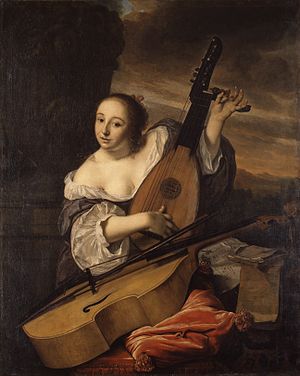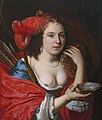The Musician (Bartholomeus van der Helst painting)
| The Musician | |
|---|---|
 | |
| Artist | Bartholomeus van der Helst |
| Year | 1662 |
| Medium | oil paint, canvas |
| Dimensions | 138.4 cm (54.5 in) × 111.1 cm (43.7 in) |
| Location | Metropolitan Museum of Art |
| Accession No. | 73.2 |
| Identifiers | The Met object ID: 436642 |
The Musician (1662) is an oil on canvas painting by the Dutch painter Bartholomeus van der Helst. It is an example of Dutch Golden Age painting and is part of the collection of the Metropolitan Museum of Art.
The woman is looking at the viewer and according to art historian
-
Honthorst, 1624
-
Honthorst, 1624
-
Bol, 1654
Liedtke wonders if it could possibly a portrait of the artist's wife, as has sometimes been claimed for the female pendant of a shepherd by Van der Helst that has often been claimed to be a self-portrait:
-
Unknown woman as Granida, 1660
This work is the only surviving painting in the Metropolitan Museum of Art that was acquired before 1906 and after the initial purchase of 1871, and though it is officially recorded as entering the collection in 1873, Liedtke mentions that it was grouped as one of two paintings that came into the collection in 1872 after the initial 1871 purchase, but also via the same vice-president of the Board of Trustees
The art historian J.J. de Gelder mentioned the lute shown in the painting is a
-
Ter Borch, 1658
-
Vermeer, 1662
The Vermeer was donated to the MET's collection in 1900, and the Ter Borch in 1914, both of which had been recently imported to the US, probably also based on the popularity at the time of this painting.
See also
References
- ^ a b c Cat. no. 77 in Dutch Paintings in the Metropolitan Museum of Art Volume I, by Walter Liedtke, Metropolitan Museum of Art, 2007
- ^ A Burgomaster of Leyden and His Wife, Oval, 46 x 36 3/8 inches, in the 1914 Metropolitan Museum of Art catalog, under "Karel van Moor", with a note that "the attribution has been questioned"
- J.J. de Gelder, dissertation on Bartholomeus van der Helst with a monograph of his work, 1921, cat. nr. 17
- Judith van Gent, Bartholomeus van der Helst (ca. 1613–1670). Een studie naar zijn leven en werk', Waanders, Zwolle, 2011, nr. 127






